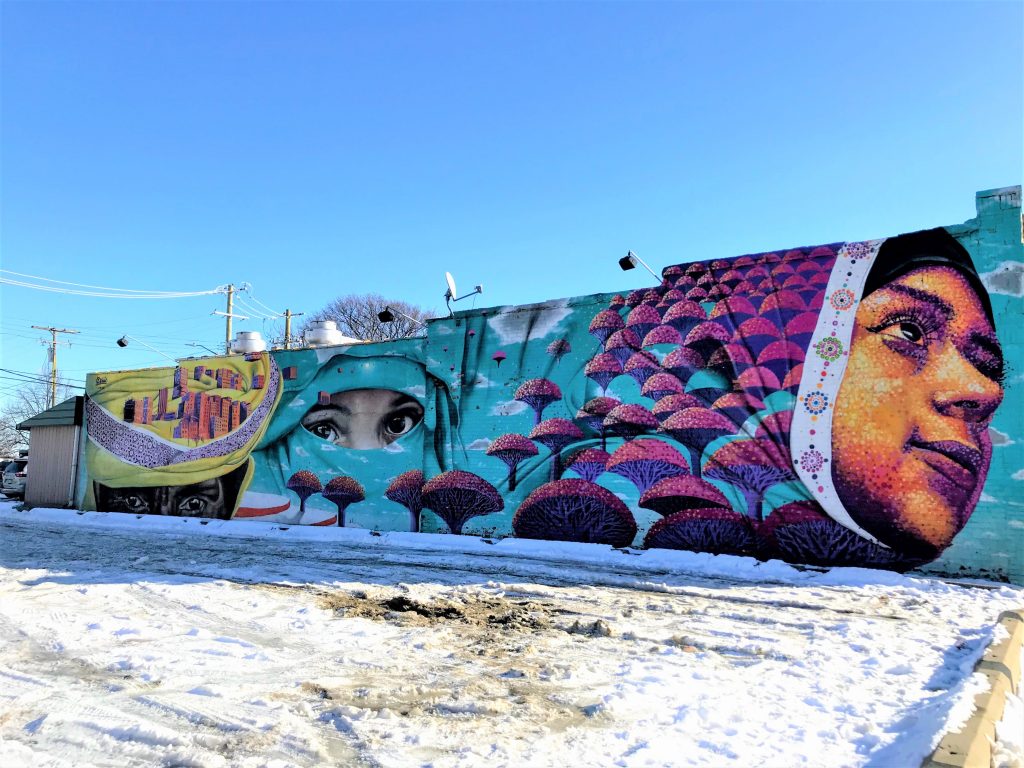Hamtramck’s ‘Yemen Mural’ Lives On, For Now
The mural by New York artist Dasic Fernandez was commissioned to dispel stereotypes about Yemeni Americans. When a developer planned to construct a building in front of it, the community rallied, and a solution is in sight.

Hamtramck, the city shaped by immigrants over a century, is famous for its melange of Polish, Eastern European, Arab and South Asian culture.
The mural dispels stereotypes “in light of the challenges Yemeni Americans face via domestic policies.” — Hanan Yahya, social entrepreneur
But one mural that exemplifies that culture, the ‘Yemen Mural’ seen above, had its future put into question prior to the pandemic when a local developer unveiled plans to build a housing complex in front of it.
Now, a solution may be within reach, preserving a celebrated part of the city’s identity while allowing development to move forward.
Click on the player above to hear WDET’s Nargis Rahman report on the history — and future — of Hamtramck’s “Yemen” mural.
Dispelling Stereotypes
Local organization OneHamtramck commissioned New York artist Dasic Fernandez in 2013 to paint the mural on the Yemeni restaurant Sheeba’s exterior wall for $23,000. The 80×16 foot mural depicts images of people and places from Yemen.
“We didn’t want word to come that there was an adversarial dynamic.” — Abraham Aiyash, Save the Mural
The mural dispels stereotypes “in light of the recent conflict of Yemen and the challenges the Yemeni Americans face via the Muslim ban and other domestic policies,” says Hanan Yahya, a social entrepreneur who was on the mural’s planning committee.
Last summer, word got out that the iconic mural might be obscured by development on the empty lot in front of it. Community members launched a “Save the Mural” petition drive which drew hundreds of signatures, and planned a protest.
A city council meeting was scheduled and then tabled. Instead, a months-long negotiations process began.
City Mediation

Hamtramck City Manager Kathy Angerer was brought in to bridge the gap between the parties, the city and Hamtramck residents.
Abraham Aiyash, a board member of OneHamtramck’s “Save the Mural” committee, says leaders from local mosques and community organizations worked behind the scenes with mediators to find a resolution that allows development and preserves the public-facing mural.
“We didn’t want word to come that there was an adversarial dynamic,” Aiyash says.
A memorandum of agreement was recently signed by all parties and approved by Hamtramck City Council, to:
- Sell an adjacent city-owned parking lot to the developer
- Convert the adjacent one-way Goodson Street to allow two-way traffic
- Deed the lot in question for a long-term lease
- Possibly create a future park celebrating Yemeni heritage
Business owners and OneHamtramck were set to sign the deal this spring, but the COVID-19 outbreak in March put plans on hold.Officials say they hope to move forward soon.
Angerer says successful negotiations are a template for solving similar challenges in other cities.
If “we can do that in Hamtramck, we can do that anywhere,” she said.
Trusted, accurate, up-to-date
WDET is here to keep you informed on essential information, news and resources related to COVID-19.
This is a stressful, insecure time for many. So it’s more important than ever for you, our listeners and readers, who are able to donate to keep supporting WDET’s mission. Please make a gift today.
